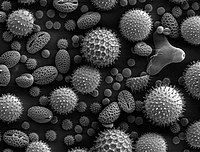Allergic Rhinitis

A number sign (#) is used with this entry because susceptibility to allergic rhinitis has been associated with polymorphisms in the IL13 gene (147683) on chromosome 5q31 and the FOXJ1 gene (602291) on 17q25.
Clinical FeaturesAllergic rhinitis is a common disease of complex inheritance and is characterized by mucosal inflammation caused by allergen exposure. Allergic rhinitis often affects patients with other coexisting manifestations of allergy such as asthma (600807) and atopic dermatitis (603165).
Molecular GeneticsWang et al. (2003) found a significant association of the IL13 arg130-to-gln (R130Q) SNP (147683.0002) with serum total IgE levels in Chinese adult patients with allergic rhinitis. Patients with a gln/gln genotype showed much higher serum total IgE than those with an arg/arg genotype.
In a Korean population comprising 295 patients with allergic rhinitis and 418 controls, Li et al. (2006) reported a significant association between allergic rhinitis and 3 SNPs of the FOXJ1 gene: -460C-T (rs880213), 1805G-T (rs1868823), and 3375G-C (rs3192453). Haplotype analysis revealed that the main haplotype, CGG of the 3 SNPs respectively, was significantly associated with allergic rhinitis (p = 0.000018). There was no association between the SNPs and serum IgE levels. Li et al. (2006) suggested that dysregulation of FOXJ1 may affect T cell activity.
HeterogeneityHaagerup et al. (2001) performed a genome scan for susceptibility genes for allergic rhinitis in affected sib pair families. From 100 Danish nuclear families selected for allergy, families containing at least 2 full sibs with clinical allergic rhinitis and elevated specific IgE against at least 1 of the 11 tested allergens were chosen. A total of 33 sib pair families qualified for the genome scan that was undertaken using 446 microsatellite markers. The data were analyzed by nonparametric multipoint linkage analysis using the maximum likelihood score (MLS) approach. One major candidate region on chromosome 4q24-q27 (lod score of 2.83) was revealed. Evidence of linkage between allergic rhinitis and the markers D4S1651 and D4S2394 defined a candidate region of approximately 13 cM that may harbor a specific susceptibility gene. Another 8 regions, 2q12-q33, 3q13, 4p15-q12, 5q13-q15, 6p24-p23, 12p13, 22q13, and Xp21, showed evidence of linkage detected by lod scores in the range of 1.04-1.63. Among these 8 regions, 2 regions were supportive of previous findings in chromosome 2q33 and 6p23 regarding asthma and asthma-associated phenotypes.
Brasch-Andersen et al. (2006) performed fine mapping in 3 independent Danish samples consisting of a total of 236 sib-pair families with clinical allergy, including the 33 sib-pair families with allergic rhinitis originally studied by Haagerup et al. (2001). Analysis of 28 microsatellite markers on chromosome 3q revealed significant linkage to 3q13.31 for rhinitis (MLS = 5.55; identity by descent, or IBD = 63.9%) and for atopy (MLS = 3.71, IBD = 61.7%). An MLS of 5.1 (IBD = 67.3%) was obtained when sib pairs with both rhinitis and atopy were analyzed.